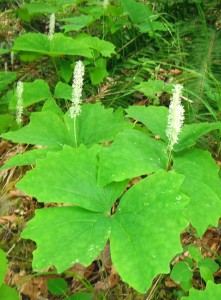
News/Reports
Nimpkish River ER #118 Overview Physical and Biological
Physical:
The reserve is part of a 2.5 km wide floodplain occurring at the confluence of Nimpkish River and Sebalhall, Yookwa and Kiyu creeks. Surrounding mountains rise to between 1000 and 1500 m above sea level. Soils in the reserve are alluvial Regosols with a loamy sand topsoil up to 1 metre thick overlying fast-draining gravel and sand. The relationship between the terrestrial portion of the reserve and the stream channels can change dramatically.
Biological:
 The forest in the reserve is primarily composed of Douglas-fir and western redcedar. Only minor proportions of western hemlock, Sitka spruce, western white pine, red alder and bigleaf maple occur. Douglas-fir dominates greatly in volume, but the number of stems of western redcedar is slightly higher. The majority of the stand belongs to a Douglas-fir redcedar-devil’s club-vanilla leaf/oak and sword fern community. Other common shrubs in this community are salmonberry, red huckleberry and bald-hip rose. The lush herb layer is very diverse and contains many species indicative of excellent growing sites, such as three-leaved foamflower, star-flowered false Solomon Seal, Hooker’s fairybells, stream violet, sweet-scented bedstraw, lady fern and bearded fescue. In the moss layer, another high-site indicator is Mnium insign
The forest in the reserve is primarily composed of Douglas-fir and western redcedar. Only minor proportions of western hemlock, Sitka spruce, western white pine, red alder and bigleaf maple occur. Douglas-fir dominates greatly in volume, but the number of stems of western redcedar is slightly higher. The majority of the stand belongs to a Douglas-fir redcedar-devil’s club-vanilla leaf/oak and sword fern community. Other common shrubs in this community are salmonberry, red huckleberry and bald-hip rose. The lush herb layer is very diverse and contains many species indicative of excellent growing sites, such as three-leaved foamflower, star-flowered false Solomon Seal, Hooker’s fairybells, stream violet, sweet-scented bedstraw, lady fern and bearded fescue. In the moss layer, another high-site indicator is Mnium insign
- Achlys_triphylla (Vanilla leaf) photo by Garry Fletcher
Overgrown but active flood channels support various combinations of red alder, red-osier dogwood, Pacific ninebark, stink currant, skunk cabbage, false bugbane, lady fern, sedges and grasses.
Roosevelt elk, black bear, deer, beaver and bald eagles are occasional visitors to the reserve forest.
